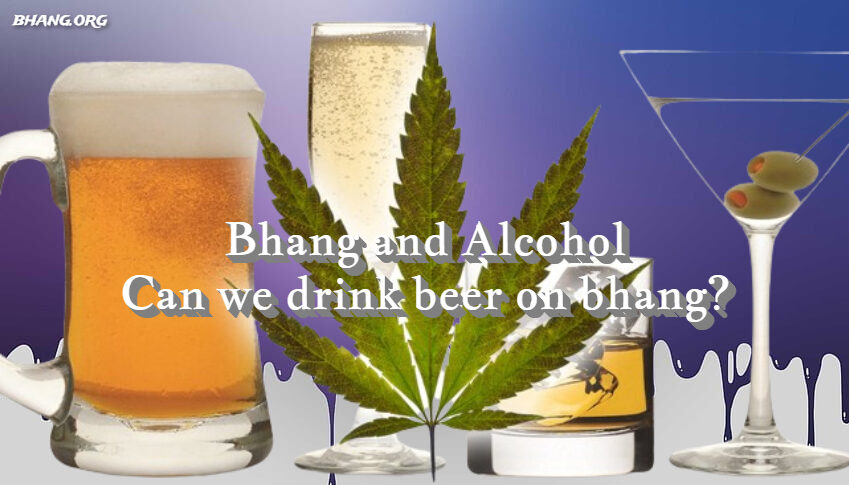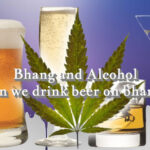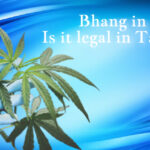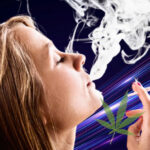It’s fascinating, isn’t it? How a country can impose significant taxes on tobacco and alcohol while simultaneously permitting the sale of a drug through government-licensed shops? Especially considering the strict bans during the British rule, one wonders how this drug managed to escape prohibition. What’s even more curious is that religions haven’t entirely opposed its use.
India’s history has deep roots intertwined with cannabis, particularly its derivative known as Bhang. Indigenous to India, it has been an integral part of our culture for centuries, often consumed as a drink during festivals like Holi and Shivratri. Its usage dates back to around 400 BCE, with mentions in Vedic texts. Presently, according to the ‘Magnitude of Substance Use in India, 2019’ report by the Ministry of Social Justice and Empowerment, more Indians consume Bhang (2%) compared to Charas or Ganja (1.2%). States like Punjab, Sikkim, Uttar Pradesh, Chhattisgarh, and Delhi show higher prevalence of Bhang usage.
But before delving into statistics, let’s understand what exactly Bhang is.
According to the NDPS policy, Bhang is an edible preparation made from the leaves of the widely available herb, Cannabis sativa. Cannabis contains potent constituents such as Cannabinoids, Terpenes, and Flavonoids, with over 100 recorded Cannabinoids, including THC and CBD. When a cultivar’s THC content exceeds 0.3%, it becomes psychoactive, capable of inducing a ‘high’. Charas, Bhang, Hashish, and Ganja are derived from such cultivars. While Charas and Ganja come from different parts of the plant, Bhang and Hashish are preparations made from its extracts. Technically, Bhang is solely derived from the leaves of the cannabis plant, often ground together with stems to create a mixture. It’s not a separate cultivar or species but a preparation from a cultivar with relatively higher THC content, capable of producing psychoactive effects.
Legal Position in India-
India, as a signatory to three international conventions, including the Single Convention on Narcotics (1961) and the UN Convention on Psychotropic Substances (1971), had to curb non-medical use of Narcotic Drugs and Psychotropic Substances (NDPS). However, the legislation failed to consider the nuanced cultural context of cannabis use in countries like India. Thus, the NDPS Act of 1985 was enacted to address this issue.
The act prohibits various activities related to narcotics and psychotropic substances, including production, possession, sale, and consumption. While the act explicitly bans the consumption of Charas and Ganja, Bhang, made from the leaves of the cannabis plant, remains exempt due to its distinct legal status.
The act defines Ganja as the flowering or fruiting tops of the cannabis plant, excluding seeds and leaves when not accompanied by the tops. Since Bhang is made from the leaves, it falls outside the scope of this definition, thus enjoying a degree of legality.
Moreover, the National Policy on Narcotic Drugs and Psychotropic Substances regulates the cultivation and use of Bhang in India.It clearly specifies that Bhang is a concoction crafted exclusively from cannabis leaves, with no inclusion of flowering tops or resins. The policy imposes restrictions on the production and cultivation of cannabis for Bhang, limiting it to wild cannabis and prohibiting commercial cultivation.
Overall, these laws and policies aim to monitor and control the use of cannabis and its derivatives, with cultivation permits granted only for scientific and medicinal purposes. Individual states have the authority to decide on the regulation of cannabis within their territories.
Exemption of Cannabis Leaves in the NDPS Act
The decision to exclude seeds and leaves of the cannabis plant from the purview of the NDPS Act stemmed from their low THC content, rendering them less potent compared to other parts. Particularly, Bhang, derived from these leaves, is considered the least potent among various cannabis preparations in India. This exemption can be traced back to colonial times when extensive studies, sponsored by the British, examined the effects of cannabis on Indian populations.
The Indian Hemp Drugs Commission Report, a product of these studies, concluded that banning Bhang would be unjustified. This was partly due to Bhang’s significant religious and cultural significance dating back centuries, where a sudden prohibition would likely result in backlash. Additionally, the report noted that Bhang was perceived as less harmful than alcohol or tobacco in the Indian context.
Consumption of Bhang
Bhang is typically consumed as an edible preparation, often mixed with nuts, herbs, and spices in the form of a milkshake known as thandai or lassi. It can also be consumed as Bhang golis or balls, which are freshly ground mixtures of Bhang and water. In addition, Bhang is used as an ingredient in various sweets like Bhang Besan Halwa and in beverages like Bhang masala Tea or Pakoras (Indian fritters). In the Himalayan regions, it is even consumed as a chutney alongside tomatoes and mint. Besides its recreational use due to its THC content, Bhang is also consumed for its purported anti-inflammatory and anti-phlegmatic properties.
Why You Should Avoid Mixing Bhang with Alcohol
With Holi just around the corner, excitement is building up for the festival of colors. Celebrated on the full-moon day of the Phalguna month in the Hindu calendar, Holi brings different traditions in households. While some indulge in flower and watercolor play, others prefer staying indoors and enjoying gujias. One common Holi favorite is bhang thandai, a milk-based drink infused with nuts, seeds, and rose petals. However, it’s essential to understand the potential risks, especially when considering mixing bhang with alcohol.
Bhang, a highly potent drug, is a key ingredient in thandai. Mixing alcohol with bhang can be akin to blending rum with heavily laced milk. The intoxicating effects of bhang, coupled with alcohol, can significantly alter judgment and lead to alcohol overdose. Here are some additional points to consider when consuming bhang:
- Avoid Consuming Bhang on an Empty Stomach: It’s crucial to consume bhang after having food. Eating throughout the experience can help mitigate any adverse effects.
- Consume Bhang Outdoors: For a safer and more enjoyable experience, always consume bhang outdoors.
- Purchase Bhang from Reliable Sources: Refrain from buying bhang from random vendors to ensure its quality and safety.
- Moderation is Key: Avoid excessive consumption of bhang without breaks to prevent potential negative effects.
- Stay Hydrated: Keep yourself hydrated with plenty of water while consuming bhang.
It’s important to note that a bhang hangover may differ from a typical hangover, so refrain from using painkillers to alleviate discomfort. Taking these precautions can help ensure a safer and more enjoyable Holi celebration.
Understanding the Risks: Can we drink beer on bhang?
Mixing alcohol and marijuana is a common practice, with marijuana being the most frequently used substance among drinkers. While some individuals combine these substances to enhance their effects or mitigate side effects, this practice can pose serious risks.
Effects of Combining Alcohol and Bhang
When alcohol and Bhang are consumed together, individuals may experience intensified effects of one or both substances, including faster onset and heightened potency.
Bhang and alcohol both affect the central nervous system. Marijuana impacts brain areas responsible for memory, pleasure, and sensory perception, while alcohol acts as a depressant, affecting motor skills, judgment, and cognition.
THC, the primary psychoactive component in marijuana, acts on cannabinoid receptors in the brain, leading to cognitive effects and impairments. When alcohol is consumed alongside marijuana, it increases the absorption of THC into the body, resulting in a stronger high. However, this combination can also amplify negative effects, such as impaired judgment.
Risks of Mixing Bhang and Alcohol
Combining alcohol and Bhang can be dangerous due to the unpredictable effects of each substance, which are exacerbated when combined. Increased THC absorption due to alcohol in the bloodstream can elevate the risk of uncomfortable side effects.
Moreover, the combined impairment from alcohol and marijuana exceeds that of either substance alone, increasing the risk of accidents and injuries. Individuals may find themselves in risky situations while under the influence of both substances.
Regular use of this combination also raises the likelihood of developing dependence on one or both substances. Attempting to reduce alcohol or cannabis consumption may lead to increased reliance on the other substance.
Additionally, consuming alcohol while detoxing from marijuana can result in higher THC levels in the bloodstream, prolonging the detoxification process.
Potential Overdose Risks
Consuming excessive amounts of either alcohol or Bhang can lead to overdose. While Bhang overdose is typically not life-threatening, complications such as inhalation burns and asthma attacks from smoking cannabis can be severe. Drinking too much alcohol can result in alcohol poisoning, which can be fatal, especially when combined with Bhang.
In summary, while mixing alcohol with Bhang may intensify the high, it also increases the associated risks, including overdose and dependence. Caution should be exercised when considering this combination.
FAQs
Is it safe to drink beer or alcohol with bhang?
Mixing alcohol and bhang can intensify the effects of both substances and pose serious risks. This combination can lead to faster onset and heightened potency, increased impairment, and elevated risk of accidents and injuries. Additionally, regular use may lead to dependence on one or both substances.
What are the effects of combining alcohol and bhang?
When alcohol and bhang are consumed together, individuals may experience amplified effects, including impaired judgment, cognitive impairment, and intensified highs. Alcohol increases the absorption of THC, the psychoactive component in marijuana, leading to a stronger high but also potentially unpleasant side effects.
What are the risks of mixing bhang and alcohol?
Combining alcohol and bhang can result in unpredictable effects and increased impairment compared to consuming either substance alone. This combination heightens the risk of accidents, injuries, and alcohol poisoning. Regular use may also lead to dependence on one or both substances.
Can you overdose on alcohol and bhang?
Consuming excessive amounts of alcohol or bhang can lead to overdose, with potentially severe consequences. While bhang overdose is typically not life-threatening, complications such as inhalation burns and asthma attacks from smoking cannabis can occur. Drinking too much alcohol can result in alcohol poisoning, which can be fatal, especially when combined with bhang.
What precautions should be taken when consuming bhang with alcohol?
It’s crucial to exercise caution when consuming bhang with alcohol. Avoid consuming bhang on an empty stomach, and ensure moderation in consumption. Consume bhang outdoors for a safer experience, and purchase it from reliable sources to ensure quality and safety. Stay hydrated with plenty of water, and refrain from using painkillers to alleviate discomfort if experiencing a bhang hangover.





Leave a Reply